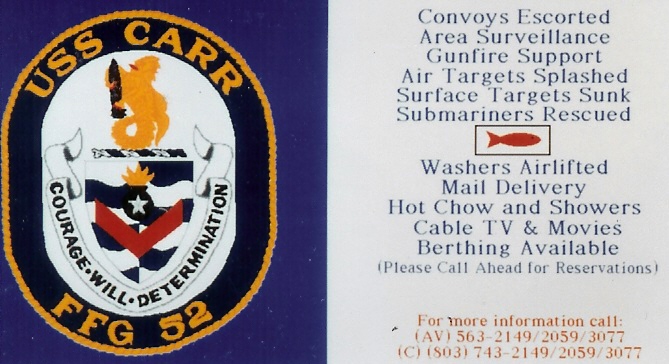 USS CARR (FFG-52) “Business Card” c.1989
USS CARR (FFG-52) “Business Card” c.1989Destiny. The USS CARR (FFG-52), freshly returned from a Persian Gulf deployment, where she escorted re-flagged “American” crude carriers entering and departing from the Strait of Homuz. With a crew of 189, bloated by a “single plane” detachment (meaning one helicopter) from HSL-44 (about 14 men – 5 pilots and 9 enlisted), added to a three helo detachment of AH-6 “Little Bird” helos from the Army Special Forces, they had professionally performed their duties, while in cramped quarters with their assigned and augmented “shipmates.” In addition to just being responsible for operating the ship and the air assets assigned, there were small boats and two armed barges in the Persian Gulf, which were also under the command of the Convoy Commodores. The CARR’s CO, CDR Wade C. Johnson regularly fulfilled this duty, which meant the CARR’s crew handled a large number of air and sea fighting craft, on top of their weapons and sensors. They were busy, but in the 4 actual months of doing this job, well versed in the techniques used and management of the apparent chaos of all the moving puzzle pieces. Few of the crew left the ship between the return to the States (22 March, 1988) and the day of 24 April, 1988.
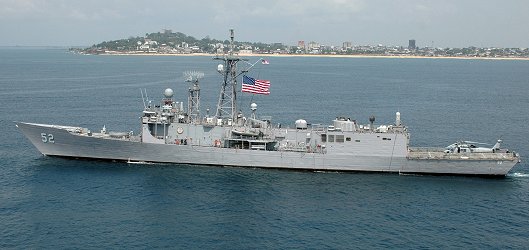 USS CARR (FFG-52) – Recent Picture
USS CARR (FFG-52) – Recent PictureFor the crew of the
USS BONEFISH (SS-582), this becomes a blessing.I only know this story through the words of those who were there, who became my shipmates when I reported to USS CARR in September, 1988. Three people, two from the CARR’s crew, and one from the USS BONEFISH have responded and provided me with their recollection of the day’s events. I also managed to find the CARR’s monthly mandated ship history reports
from this time period. I do not know exact time frames, as the inputs and my recollection of CDR Johnson’s recitation differ, so please discount such conflicts and know there is far more to be researched.
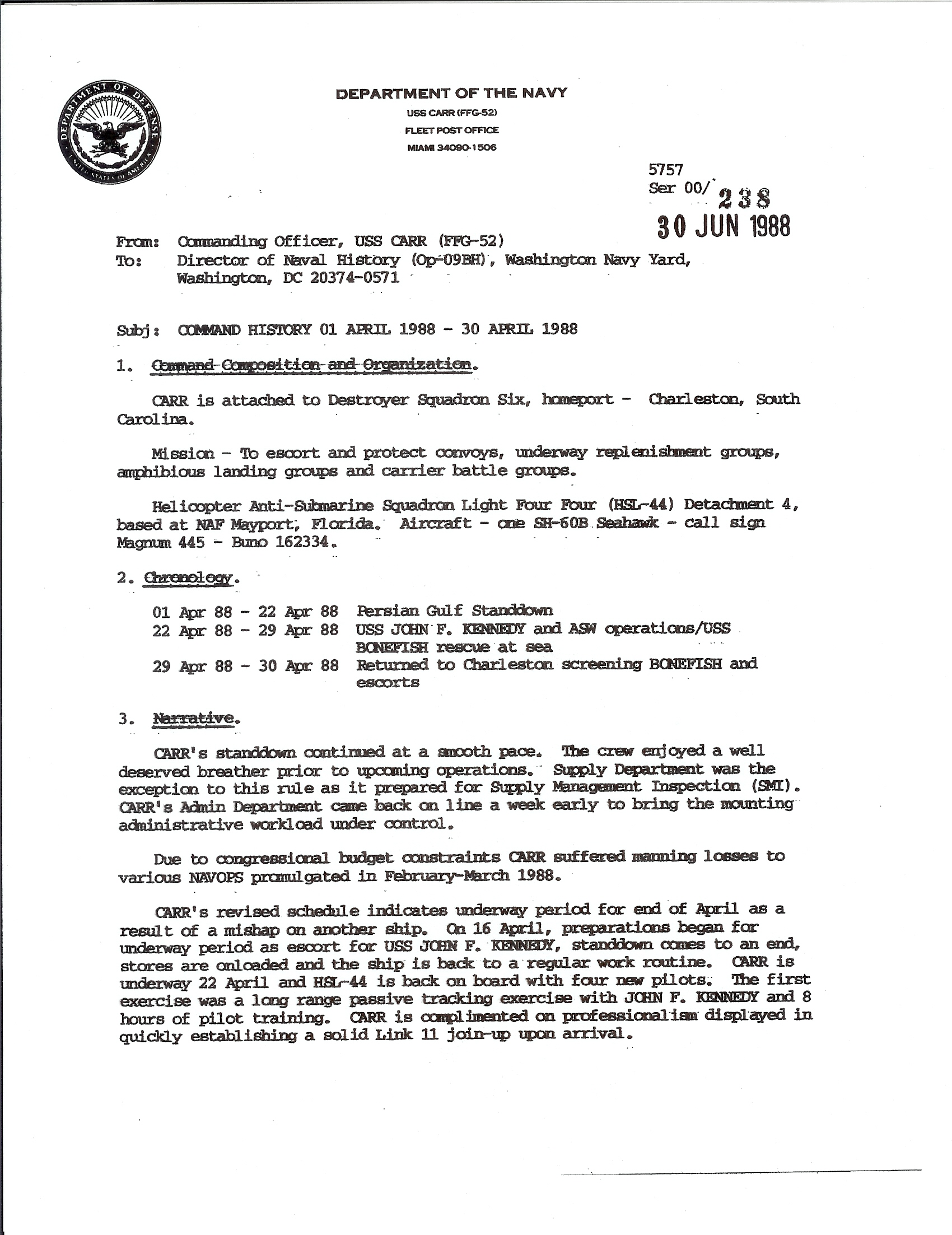
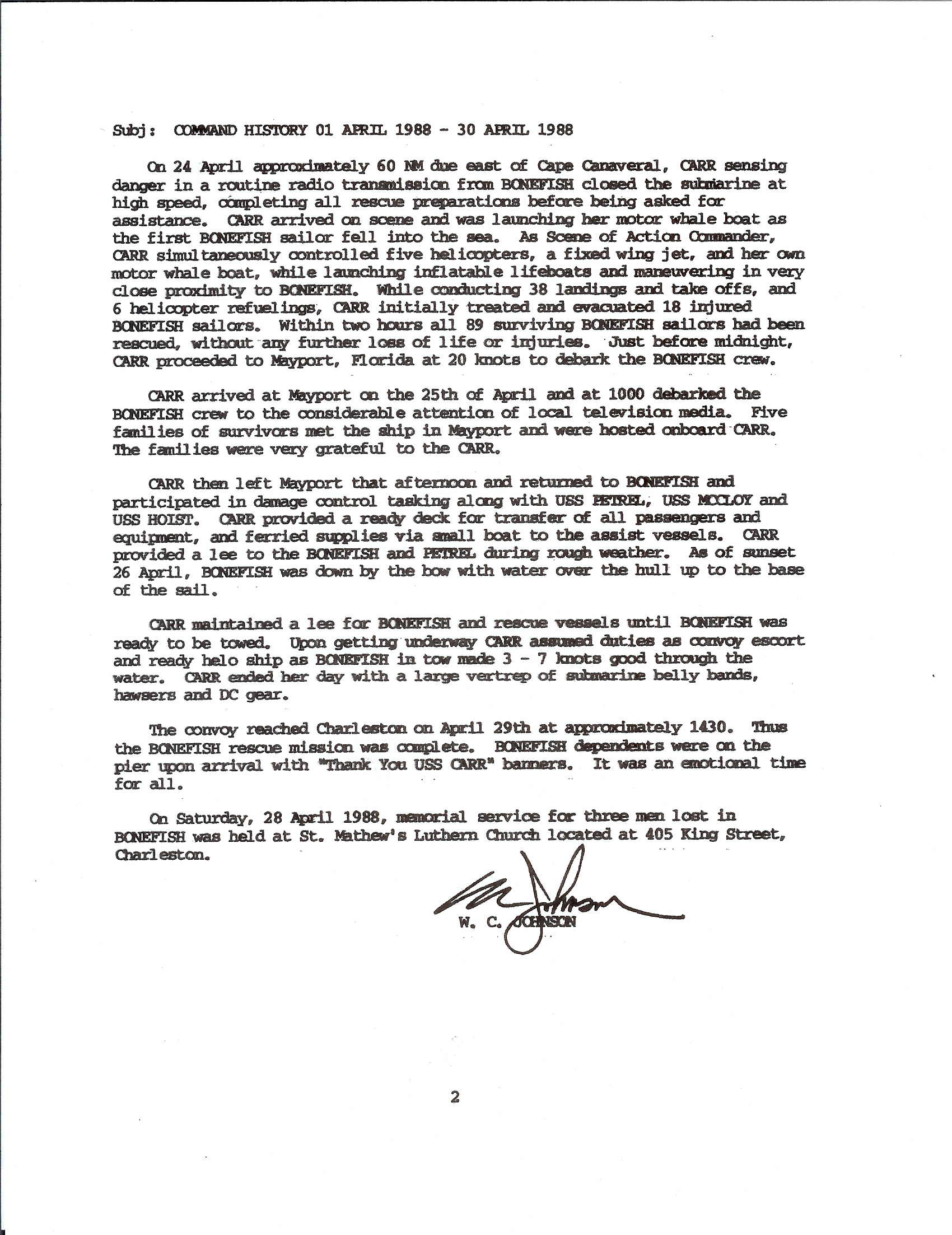 Click each page for a larger image
Click each page for a larger image
The story of the fire at sea began, as told by CDR Johnson, like so (I will paraphrase the report):
We were sitting eating supper, when the OOD [Officer of the Deck] called the Wardroom to inform me that the BONEFISH had reported via GERTRUDE [underwater radio] that she had a fire aboard, it was under control, but she was surfacing. I told the OOD to put the second engine online and to get over to the last known position of the submarine. The worst we’ll look is foolish, but if they need us, we’ll be right there.
From the Wikipedia BONEFISH entry:
On 24 April 1988, Bonefish was exercising with the guided missile frigate Carr (FFG-52) 160 miles off the coast of Florida. While the sub was submerged, seawater began leaking onto cables and electrical buses in a battery supply cableway. Electrical arcing between cables caused an explosion which flashed into a fire within minutes. Temperatures in the battery spaces reached 1,200 degrees. The heat melted crewmembers’ shoe soles in the spaces above. Bonefish was surfaced and its crew ordered to abandon ship. Eighty-nine crewmembers were rescued by whaleboat and helicopter crews from Carr and John F. Kennedy (CV-67).
The CARR’s OOD ordered the EOOW to bring up the second engine, which was started by the Propulsion Systems Monitor, GS2 Shawn Hubbartt, as directed by the EOOW brought the engine online.
GSM2 Hubbartt:
I was stationed onboard the USS Carr (FFG 52) and we were out to sea operating with the USS John F. Kennedy (CV 67) somewhere off the coast of Florida that I can remember.
I was a GSM2 at the time and working in the Main Engine Room when the CO came across the 1MC informing the crew that a diesel submarine who was operating with us had surfaced very close to the Kennedy on her starboard beam… Working in Engineering, I didn’t get to see much sun light so I went up to the starboard side main deck by the torpedo tubes to go look… I could see a small submarine on the surface in broad daylight right off the starboard beam of the carrier. I didn’t think much of it at the time except that it was rather rare for a diesel sub to surface in broad day light.
I was on watch on I think at the time the 1600 – 2000 watch… I think that was the watch rotation I was in for that week. The CO came over the 1MC again only this time he said that we have a ship in distress and that we are running at high speed to go assist… He said that the USS Bonefish had a casualty at 500 feet, had to emergency surface and we were to go assist them.
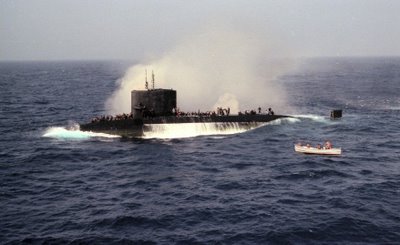 USS BONEFISH 24 April, 1988 USS CARR’s motor whaleboat
USS BONEFISH 24 April, 1988 USS CARR’s motor whaleboat
Photo Credit: Paul Perris on navsource.orgH/T:
Hundreds of Fathoms Blog for the pictures of the rescue.The emergency aboard the BONEFISH was a fire in the battery compartment. CTC Rod Frank was on board BONEFISH as a Sonar Seaman:
I will tell you what I remembered.
We were out on a 2 week exercise with the USS CARR, USS KENNEDY, and the USS STURGEON. The exercise was completed early on the 24th and most were headed home. The KENNEDY was already 50-60 miles away when the fire was called away.
I had just completed my submarine qualification board that morning as well so I was pretty tired and I went to my rack for a couple of hours. Around 1600 there was a 1MC announcement that there was an unknown ground on the forward battery well. Most of our fire drills started this way so my first thought was that we were going to do another drill. The next thing I know one of our electricians come in and he empties a CO2 fire extinguisher into the forward well. I moved out into the passage way to assist as much as possible. There were a couple of key players one A-ganger and a couple of electricians trying to put out the fire.
The next thing I know here comes a fire ball out of the overhead and it blows me and the other guys that were chained together through our EAB’s into the crews mess. I remember thinking that those guys are all dead the fireball rolled right over their backs and didn’t do the damage that it could have. By now though we cant see a thing in the midships compartment. It is completely black. We lost comms a few minutes later and we could feel the flames rushing across the battery well under our feet. The next thing that I remember was someone passing the word to abandon ship.
CDR Johnson described the next part of the operation:
We came up to the BONEFISH’s position at full speed, when the sub popped to the surface, the hatches came flying open and the crew was piling out like ants getting out of their nest after being disturbed. Smoke was billowing from the sub from all three of the deck hatches. I ordered 5 life rafts (the encapsulated ones) into the water and to get the motor whaleboat ready to tow them to the sub.
ET2 Joe Smirniotis witnessed this happening:
I remember seeing the black smoke rising from the hatch of the Bonefish, men exiting quickly. I asked the XO if I needed to film it and I ran to IC Gyro and got the ships movie camera. I video taped it all. The life rafts being deployed and the motor whale boat.
Our crew was willing to do all that was needed. These are our ship mates needing our help and our prayers.
Our rafts did not work. I remember 2 out of 5 inflating and one of them only part way, the top did not inflate.
CDR Johnson told me two of the rafts just hit the water and kept going down. Those were a major item inspected by the Board of Inspection and Survey, specifically to get a feel for the reliability of them. This incident supported the fleet knowledge I had that the failure rate was 50% as observed by the INSURV inspectors.
The LT Robert “Bob” Threlkeld was the Engineer Officer on CARR. CDR Johnson told him to get in the whaleboat, go over and find the CO of the BONEFISH, CDR Wilson, and bring him back aboard. Bob did. He told me he climbed aboard the sub and walked among the crew until he found the CO. He noted the smoke coming from the hatches was the worst thing he had ever smelled.
The BONEFISH CO and Bob returned and headed for CDR Johnson’s cabin. To the day CDR Johnson left the CARR in Sept, 1989, he kept the small dry erase board, with the drawing intact, that he and the sub’s skipper used to sketch the basic interior of the sub, to decide if they should mount an effort to enter the sub and fight the fire/look for survivors. The decision was there really wasn’t a chance to do that.
Sometime early in the disaster, a HS-3 SEA KING from the KENNEDY came and hovered over the BONEFISH, dropping the “horse collar” to the stricken submariners. CDR Johnson, from his close vantage point, noticed the submariners didn’t know how to get into the rescue hoist apparatus properly. He directed the CARR’s air controller to order the KENNEDY’s helo away, and to send in the HSL-44 SH-60B. Once overhead, the HSL-44 helo sent the rescue swimmer to the sub, who then assisted the BONEFISH crew in getting hoisted and flown to safety.
From STSN Rod Frank:
We didnt know if we were surfaced or not but someone went up and opened the hatch and we started to get topside. I remember that when I got up there were maybe 40 or so of my shipmates hanging on to the safety track and we could see helos coming at us. The first one came in and a swimmer jumped off and came to help get us on board. By that time we also had a life raft over the side and some guys were climbing into it. I hung around and waited for one of the helos. I left with the XO and we were taken to the CARR. These guys took us in and made us as comfortable as possible. We were all in shock this whole evolution unfolded in less than a half an hour. We spent the next few hours trying to locate our friends not knowing if they survived or not. Some of the injured were flown to the KENNEDY for medical treatment.
Shawn Hubbart reports from his view point:
I monitored the start of the standby GTM, and then waited to see what was happening… I heard the engines slow down to idle and then I went up to the port side escape trunk to go take a look at the sub.
I saw that we were quite close to a submarine on our port quarter. Then I saw the forward hatch open up and a lot of brown smoke started pouring out of this thing… I’d only been in the Navy for only about 2 years, but I do know that this couldn’t be a good thing… There isn’t anywhere to run on a submarine when there is smoke, especially brown smoke.
Then I saw a lot of sailors climbing out of the sub in what I refer to ants running out of an ant hill with water rolling in. Not a correct statement to make but it started me to see these fellow sailors cling onto this submarine on the open ocean with nothing to hold on to. I remember that we set flight quarters and we launched our motor whale boat to pick up these sailors…
Several helos were flying around us and the sub. We had our helo up in the air and I guess the Kennedy had theirs up as well…
During this this rescue operation, the “normal” communications paths were bypassed in favor of a “COTS” (Commercial Off The Shelf) system that had been in the fleet for only a few years at this point: The Joint Operations Tactical System or simply “JOTS.” While there were all the voice circuits and teletype communications available, the JOTS “OPNOTE” system, basically what we know today as email, was used to communicate directly between the On Scene Commander (CARR) and Commander, Atlantic Fleet (CINCLANTFLT). The status reports and rescued crew rosters were sent to the CINCLANTFLT Command Center, giving the Fleet Commander a first person story of the action. OSC(SW) Mike Bennett was the one I understand that kept the messages flowing as the leading Operations Specialist.
The evacuation of the BONEFISH continued, with triage being performed by HMC(SW) “Doc” Mentzer. Some of the submariners, in need of more detailed medical care were flown to the USS KENNEDY, I believe about 14 of them.
Shawn Hubbartt;
We picked up several of the sailors from the Bonefish and took them onboard with us. I remember hearing that we picked up about 80 or so sailors and there were about 14 who were seriously injured that went to the Kennedy.
Below are the accounts of what happened as the BONEFISH sailors came aboard:
Joe Smirniotis:
As the crew of the Bonefish came aboard they were given soap to shower, clothing and shoes to wear by the crew, I gave up uniforms and my tennis shoes. They were so happy.
Shawn Hubbartt:
We, the crew, gave the Bonefish sailors some of our coveralls, dungarees and shoes to wear since they had lost everything they had on the sub. We pretty much gave everything we could to these sailors since we had just had a pay day about a week or so prior to this accident. It was the least that we could do for them… I personally thought I could have given him more if he had wanted it.
I remember one sailor in particular. I don’t remember his name but I gave him my pair of tennis shoes and my rack for the night. We would be heading home to take these boys back to Charleston, SC.
I talked with this sailor and showed him what I do on the ship and he told me what he does. He was an EN3 and his job was the “Oiler†in the engine room onboard the sub. I didn’t know what that was but he told me that it was his job to oil the piston heads and valves on the main diesel engines when they were operating.
I showed him the diesel generators onboard and I remember him telling me that we had it easy with these diesels since there were valve covers on them.
The details beyond this point in the operation we’re too widely discussed, but I can comprehend the efforts made, the details and specific, seemingly small tasks that had to occur to result in the positive outcome that we know. Putting several rafts and the whaleboat in the water, crewed for rescue and assistance (R&A) work, controlling multiple helos and reporting to higher authority, while also coordinating with the KENNEDY for support is a huge task. CDR Johnson, while recounting this to me, said “We could not have done this if we had not had the experiences we had in the Persian Gulf.” He was convinced a good crew would have struggled at all of this, but to the then present crew of the CARR, making that many “puzzle pieces” work together was second nature. His point was it is an acquired skill to be able to listen to multiple radio circuits, have a conversation, listen to voice reports, direct things to happen and report up the chain of command. I have been in such positions and it takes time to train yourself to listen for the “right” words for the present situation and then focus on whole sentences coming your way when a key word is picked out of the other noise.
Rod Frank:
I cant tell you enough how much great the crew of the USS CARR was to us. Their search and rescue team were completely professional. They did an amazing job getting 92 of 95 Sailors off that burning submarine. Then they tried their best to make us comfortable for that long ride to Mayport.
The CARR took the BONEFISH survivors into Naval Station, Mayport, on April 25th, then returned to the scene and provided support to the submarine rescue (USS PETREL) and salvage (USS HOIST) ships that had arrived. USS MCCLOY (FF-1038) was also on scene to assist by this time. CARR was the ready flight deck for the receiving of supplies from shore for the salvage ships, and provided a lee for the smaller vessels during rough seas.
Shawn Hubbartt:
We pulled into port I think the next day so we could send these sailors home. Then we went back out to sea to watch over the Bonefish and the rescue efforts.
When we got back out to the area where the Bonefish had surfaced, there were a couple of ARS ships out there along with their dive teams. I think the USS Grapple and USS Grasp were there.
I remember hearing that the divers from the ARS’s were trying to keep the Bonefish afloat since the fire that was onboard had gutted the ship. The divers were trying to fill up the forward ballast tanks with High Pressure Air to keep her afloat for the tow.
Rod Frank:
We pulled into Mayport the next morning and we were flown from there to Charleston SC still without knowing who made it and who didnt. We learned a couple of days later that 3 of our shipmates didnt make it off that day.
Upon completion of the initial salvage and securing work, CARR escorted the BONEFISH, under tow, back to Charleston. Arriving approximately 1430 on the 29th of April, the CARR was met by a large banner made by the families of the BONEFISH crew men saying “Thank you, USS CARR.” CDR Johnson said the families came aboard to personally express their thanks for the work of the crew.
Not all of the BONEFISH’s crew survived. Three of our shipmates perished in the fire:
- Lt. Ray Everts
- 1st Class Petty Officer Bob Bordelon
- 3rd Class Petty Officer Todd Lindgren
CDR Johnson told me all three of those men had recently reported aboard and were found in their working spaces. Do you ever think those semi-annual “Emergency Egress” drills from you berthing and work spaces are unnecessary? I found some ships, while years after this I was an inspector, and noted some made it a point to hold this training for all newly reported crew members with in 72 hours of their reporting aboard, then they would enter the 6 month training cycle with the other crewmen.
Update 4/26/2007:
From QM2/SS Richard Neault, another account from a crewman of the BONEFISH. It tells something of the fate of the three men named above, as well as provides more details on the operational conditions during the fire:
At the time of the accident I was on watch in the control room. I was a Quartermaster and at the time was a third class (Qm3/ss). We were operating with the USS Carr (FFG 52) and the JFK (CV 67) doing war games. The Carr had asked us to go deep to commence an operation, we were at periscope depth (PD). We started to go down to 250ft and the boat took on a down angle. At that time, the maneuvering room called up and said they had lost the ground on the battery well. The officer of the deck (OOD) told them to wait until we reached depth and then send a man into the well to see what was wrong. After we had reached 250ft, a man was sent into the battery well to find the problem when he then called out fire in the berthing spaces. The battery well is located under the berthing spaces. From there it gets kinda foggy for me as I did not monitor the phone communications. About 15 minutes after the fire alarm was sounded, there was a loud bang and the boat began to shudder. Instantly the boat filled with smoke. VERY thick and heavy black smoke. It came rushing into the control room and filled the room in about a second. By then the CO had already ordered us to PD, but when the smoke filled the compartment, the CO ordered an emergency blow. We surfaced, unfortunately the OOD was not wearing an emergency air breathing device (EAB). He was unable to get the hatch open and unfortunately succumbed to smoke inhalation. His name was Lt. Ray Everts. A quick side note, all three of the men who died in the fire were fairly new onboard. I had just had a conversation with Lt. Everts about the Quartermaster division on the Bone. He said that we were the best Qm division he had worked with thus far in his Navy career. He was a good guy. After we had surfaced, we were eventually able to get the control room hatch open and start one of the diesels. We used it to suck the smoke out of the compartment. The men fighting the fire were trying to get to the flames. Unfortunately, the fire was in the insulation that was located behind the walls in the berthing compartment. We would have had to remove the bunks and then the walls in order to get to it. They sure tried though. After we had been surfaced for about 15 minutes there was another loud bang and once again the compartment filled with heavy smoke. This time it flamed out the engine and aparently it had melted through an air line. At that point the CO realized that the fire was now being fed by this air line and the only thing left to do was to abandon ship and lock down the hatches and hope it burned itself out. Unfortunately, Robert (Bob) Bordelon (RM1/ss) had some sort of medical emergency (heart attack??) in the radio room and was already unconscious. YN3 Todd Lindgren was at the midships hatch waiting for his turn to go topside when he snapped (freaked out) and disappeared into the smoke. The Doc tried to locate him but was unable to due to the smoke. He was 20 years old, old enough to die for his country, but too young to buy a beer. RM1 Bordelon was less than a year from retirement. The official cause of the fire was an electrical short across the battery bus ties that eventually caught the insulation on fire. The Garbage Disposal Unit (GDU) in the crews mess had a leaky valve. That valve had apparently been leaking for some time and the salt water ate through the decking into the battery well. When we made our angle to go down to 250ft, the water that had pooled poured into the well and caused arching and sparking and from there it is now history. Had there been an explosion due to the buildup of hydrogen gas (as some sub experts claimed), you wouldn’t be reading this because I would be dead. Several of the crew of the Bone have been subsequently retired from the Navy for various reasons, including myself. Mainly because of the rumor and speculation surrounding the accident. Unfortunately, those of us who wanted the subs to be our career have had a hard time readjusting to civilian life. It isn’t that we were blamed by the Navy, its just that crews on board other boats felt that we didn’t do enough to save our shipmates, even though they were not there to actually be aware of what happened.
End of update 4/26/2007
As the CARR Command History for April 1988 reports, a memorial ceremony for those who died was held at St Mathews Lutheran Church at 405 King Street in Charleston, SC on Saturday, 28 April, 1988.
On December 23rd, 1988, Commander, Destroyer Squadron SIX, CAPT Jerry Lewis, awarded the Meritorious Unit Citation (MUC) to the USS CARR (FFG-52). Several Navy Commendation and Appreciation medals, and Letters of Commendation were also presented to the crew for their professionalism during this rescue at sea.
Here is a reflection by then GSM2 Shawn Hubbartt to wrap up his story, one with the appreciation gained from disaster:
Later on the magnitude of the fire finally came to me when I learned about the severity of the fire. I wasn’t aware that there were sailors who perished in the fire. I remember reading about the fire onboard the Bonefish and I was amazed of how severe that fire was and how fast the fire spread. A fire onboard any ship is dangerous no matter what. But I guess I took some of it for granted since I was on a surface ship and I could go out topside and get some fresh air every once in awhile.
The final word goes to Rod Frank:
The CO’s name for BONEFISH was CAPT Wilson. I don’t know much about him. He had just taken over from CDR Toney and this was his first underway period with us after an extended in port period. We had some issues that needed fixed and we were pierside in Charleston for almost 2 months before the exercise.
I do know that if he hadn’t ordered us to abandon ship when he did most if not all of the crew would have died in the fire.
Hard decisions had to be made, and thankfully, many are here to tell the tale.
I am thankful to GSCS Shawn Hubbartt (still on active duty, stationed aboard DDG-88), Joe Smirniotis and Rod Frank for their first person reports. I contacted them via Navy – Together We Served, which is a tremendous asset for such work.
Tracked back @: stikNstein, Castle Argghhh!, Third World County




